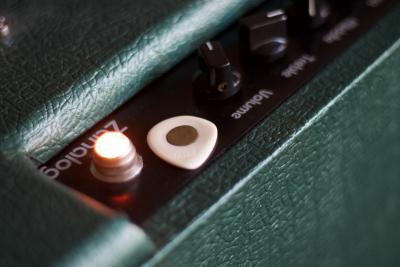now playing:
- main
- 1
- 2
- For members3
- For members4
- For members5
- For members6
- For members7
- For members8
- For members9
More
- Picking Hand BasicsLEVEL 2Introduce yourself to alternate picking the easy way.
- Alternate Picking RiffsLEVEL 6140 BPM heavy progression - improve your timing and speed!
- Strict Alternate PickingLEVEL 6The most aggressive-sounding picking there is. NB not for the faint-hearted!
- Chicken Picking MadnessLEVEL 3In this lesson I'll show you the basics of chicken picking.
- Alternate Picking ComboLEVEL 9Speed picking workout, showcasing different techniques of alternate picking - hand, wrist and pick angles. Get familiar with a few approaches and choose the best solutions for Your own playing.
- Picking WorkoutLEVEL 2For beginners ready to move on from chord strumming. The exercise is prepared with harmonic content to make practicing more interesting.
- Alternate Picking 2LEVEL 3Moderate tempo (8th notes in 160 bpm), neoclassical picking practice, combined with basic major and minor shapes. Palm muting added to make "question-response" contrast. Good warm-up for beginner alternate pickers.
- Alternate PickingLEVEL 5Right hand exercise, dressed with famous Cannon Rock chord progression. Bored while practicing with metronome? Check this out. Practice alternate picking with different rhythm values. Improve switching between different speeds in the same tempo - from quarter, through triplets to 16th notes.
- Alternate Picking WorkoutLEVEL 5Alternate Picking lesson at the level 6. Contains medium fast picking and different variations of licks - ascending, descending and two string skipping options. Speed itself is not as much the challenge, as the position shifts and string skipping.
Feedback
 azureus12th February 2021
azureus12th February 2021
Thank you Darius for all your very cool melodies ... I hope it makes me better .. although they are very difficult huh ... for me Darius Wave24th June 2020
Darius Wave24th June 2020Great to hear this Nick! Hope you can get even more profit out of my alternate picking lesson. Keep us updated with your progress

 Kristofer Dahl24th June 2020I had a breakthrough on video 4! This is awesome!
Kristofer Dahl24th June 2020I had a breakthrough on video 4! This is awesome!
Awesome to hear Nick - congrats!!! 👌Nick Filipoff24th June 2020
I had a breakthrough on video 4! This is awesome!
 Phil6626th April 2016
Phil6626th April 2016I'm working on this now, if you look here Marty explains what you are talking about in part 2 with the extra noise from other strings https://www.youtube.com/watch?v=fwP0gUBCVIU
Thanks for this lesson Darius. Darius Wave4th October 2015
Darius Wave4th October 2015you welcome!

 GuillaumeLucas4th October 2015
GuillaumeLucas4th October 2015Excellent lesson, I realized that my technique was not good. Thanks you Darius!
 ChrisGLP3rd September 2015
ChrisGLP3rd September 2015Thx for this great and useful lesson. This is now one of my daily exercises...

 Tagaluchi18th March 2015
Tagaluchi18th March 2015Great lesson man!
 Darius Wave22nd April 2014
Darius Wave22nd April 2014Well thank You my friend! That's very kind of Yours

srpanopticon22nd April 2014
I'm quite confident I've read and/or seen everything on right hand minutiae available in the world...this is by far the best detailed explanation I've ever come across. Superb.
 Darius Wave13th March 2014
Darius Wave13th March 2014Thank You Kristofer! I was hoping to do something I the was hard to find when I was learning how to do this. I hope I could save some time for our students struggling with their right hand workout

 Kristofer Dahl13th March 2014
Kristofer Dahl13th March 2014This is probably one of the better picking lessons I have seen - awesome work Darius!
 Darius Wave6th March 2014
Darius Wave6th March 2014Thank You mate! I was really hoping it can help some of You

 Ricky95th March 2014
Ricky95th March 2014This is so important, sometimes when we been playing for a while, we forget and develop bad habits. This is a great refresher. Thanks a lot!!!!!!
 Darius Wave23rd February 2014
Darius Wave23rd February 2014Thank You Guido!

 Guido Bungenstock23rd February 2014
Guido Bungenstock23rd February 2014Great lesson & really accurate playing, Darius! And really funny to, haha. I like this!!!
 Storm Linnebjerg22nd February 2014
Storm Linnebjerg22nd February 2014No problem. I would love to see more lessons like this with more spoken material.
 Darius Wave22nd February 2014
Darius Wave22nd February 2014Thank You Ben! I'm really glad You appreciate it

 Storm Linnebjerg22nd February 2014
Storm Linnebjerg22nd February 2014Very nice to see some more beginner aimed lessons with more spoken material as well! Good job, Darius!
 Darius Wave14th February 2014
Darius Wave14th February 2014Thanx Ben! Indeed as we spoke before - we had similar idea to share some thoughts about different approaches to alternate picking.

 Ben Higgins14th February 2014
Ben Higgins14th February 2014Brilliant lesson, Darius !! These are the details we like to talk about

 Darius Wave14th February 2014
Darius Wave14th February 2014Your wellcome! Thx Mark!

 mroberts7014th February 2014
mroberts7014th February 2014Excellent! Thanks for the needed info!
 Darius Wave14th February 2014
Darius Wave14th February 2014Thank You Diego!
Romko...well it's a huge loss Unfortunately I don't speak any other languages than my own and english..
Unfortunately I don't speak any other languages than my own and english..Romko14th February 2014
A wonderful lesson. Too bad I do not understand English )
 Diego Budicin14th February 2014
Diego Budicin14th February 2014Awesome and fun Darius!! Love it!!

 Huargo13th February 2014
Huargo13th February 2014like!
 Darius Wave13th February 2014
Darius Wave13th February 2014You're wellcome. Let it surve You well

Anders Karlsson13th February 2014
Very informative thank you.
 Darius Wave13th February 2014
Darius Wave13th February 2014Wow ! What a surprise Piotr

 Piotr Kaczor13th February 2014
Piotr Kaczor13th February 2014Extremely helpful lesson, Darius! This is something for me, cause I have to reconsider my picking technique. Thx!

 Hajduk13th February 2014
Hajduk13th February 2014Thats awesome Darius
 thank you it does clear up so much.
thank you it does clear up so much. Darius Wave13th February 2014
Darius Wave13th February 2014You Hajduk and a few other students were inspiration to make lesson like this
 I hope it will clear a lot of doubts
I hope it will clear a lot of doubts 
 Hajduk13th February 2014
Hajduk13th February 2014That was awesome
 so much good info there, Thank you.
so much good info there, Thank you. Darius Wave13th February 2014
Darius Wave13th February 2014Hope it will help some students to improve their picking and get familiar with some basic mechanisms

 Monica Gheorghevici13th February 2014
Monica Gheorghevici13th February 2014Awesome and very useful lesson!!! Very fun the main video

- Lesson
- My notes
Hi there GMC friends!
Welcome at my alternate picking basics lesson!
This time we will focus on some basics of how to become an efficient alternate picking player. Lesson is suitable for people at different levels - beginners as well as intermediate-advanced players. You might already know some solutions, showed in these videos but You might be also able to find some tips, that will help You to skip to another level.
This lesson contains a few different approaches to:
1. Hand position
2. Resting points
3. Wrist angle
4. Pick angle
5. Pick thickness choice
6. Practice routine
In the last part (video part 9) You will find an example of very simple looking, but yet very good exercise.
You are able to use it from 20 bpm to even 200 bpm according to Your skill level.
Warning:
Lesson shows a few ways to improve Your alternate picking skills. You can also find a lot of other ways, looking at other players. Some of them might even be extremely weird. This only proves that if You practice enough You can get anything You want working. Consider this lesson as an example of a few very common solutions You could find within skilled and very popular players.
Gear used:
* Hufschmid H6E "The Dragon" electric guitar
* Presonus Inspire 1394 audio interface
* TSE X50 amp plug-in with catharsis 1on-pres5 cab impulse for solo guitar
* Ernie Ball 10-46 regular slinky strings
Tuning: standard tuning E-A-D-G-B-EFrom this course:
Jump to start: Home or `s` , you can also click/tap the lesson part again (the numbers above player)
Go to next part: PageUP or End.
Volume: ArrowUp / ArrowDown keys
Go to any part: Number keys (combinations also possible)
Pause or play: `k` or space key
Fullscreen: `f`, esc to close
Increase / decrease speed : `+` or `-`







